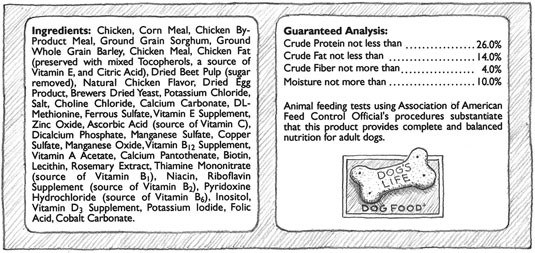
Feeding Fido: Is Kibble Still Okay? [8 counter points to the agenda against formulated pet food]
Circulating Video Against “Kibble”
The link above is to a video that has been circulating the internet. It captured my attention as it uses scare tactics to keep pet owners from feeding a balanced pet food (feeding kibble). I feed my fur baby dry dog food formulated for her physiological state with the addition of plenty of treats and even some human foods. Additionally, Ward Laboratories Inc. participates in the Association of American Feed Control Officials (AAFCO) proficiency program. Therefore, pet food and pet food ingredients are tested in our laboratory. Here are my 8 points of to alleviate pet owners of any guilt for feeding kibble:
1. Kibble is Formulated for Dogs
Dry dog foods have been formulated for dogs in all stages of life at varying physiological states. Therefore, it should not be assumed that pet owners buy one form of “kibble” and feed it without variation through-out the pet’s entire lifetime. Many pet owners will change dog food from different life stages and include treats as a routine addition in their pet’s entire diet. Read the AAFCO statement which qualifies the products as balanced and complete either through feeding trials or laboratory testing of the feed to ensure the nutrient values are in line with an already approved product.
2. Raw Pet Food has More Pathogens
The trendy RAW diet for pet food has a higher incidence of food borne illness. Salmonella and Listeria are just two examples of microbial pathogens more likely to be found on raw pet food than dry kibble or canned wet food. These food-borne pathogens also are zoonotic and therefore, can affect the entire family if say mom feeds Fido and then prepares dinner for the rest of the family.
3. Feeding Kibble is Sustainable
In this video, using “run off” from the human food industry is touted as sub-standard. I beg to differ. Using organic waste from human food facilities ensures the products are strictly analyzed to ensure food safety and hazard prevention prior to being processed into dog or cat food. Additionally, these ingredients are regulated under the Food Safety Modernization Act (FSMA), further improving the safety of your pet’s food.
Organic waste often includes certain parts of various food products such as cull carrots, pea shells, beef liver or tongues. Just because they don’t fit our consumer aesthetics and taste preferences does not mean they have no nutritional value. For convenience, these organic materials are processed into dry pellets for storage safety and easy distribution. By utilizing organic waste from human food processing plants, the cost of pet food manufacturing is lower. Making good quality food more affordable for the consumer while simultaneously preventing those materials from falling into landfills is definitely a bonus for the environment.
4. Micronutrients
Making your own pet food at home is the pushed as the best alternative to feeding kibble. This will result in mineral and vitamin deficiencies. Complete and balanced diets are precisely formulated based on the species and physiological state of the pet. If specific nutrients are not provided, these deficiencies will affect your fur baby’s health. It is not as simple as frying some hamburger and adding some rice to the mix. Vitamin and mineral supplements will need to be added at the right concentrations to meet the animal’s requirements without causing a potential toxicity. Pet food companies spend a lot of money to employ educated professionals to formulate good, wholesome products for your pets.
5. Dogs and Cats are Omnivores
Dogs and cats are not just carnivores. They are domesticated species, which have evolved from hunting their own food to begging for scraps from our diet. An all meat diet can be hard on your pet’s health. It is specifically hard on their kidneys. Pets on all meat diets can form painful kidney stones due to calcium and phosphorous imbalance. An all meat diet will also contain a deficiency of readily available carbohydrates. Carbohydrates are a necessary energy source for animals.
6. Pet Owners Should Read Labels
Yes, misguiding labels are an issue. A well-educated consumer should be aware that labeled ingredients are often the result of splitting. Some pet food labels will split plant ingredients for example, ground rice, rice flower, and rice bran, so that a meat ingredient can appear first on the ingredient list.
7. Recalls Happen for Raw Food and Kibble
To expect an industrialized manufacturing industry of any sort to never have a recall is over the top. Recalls on human food products are just as common as recalls on pet food. The last one I can remember that affected how I grocery shopped was a recall on Sabra humus, but it passed, and I still enjoy a healthy snack of carrot sticks and humus from time to time. Additionally, there are recalls on both “kibble” and raw pet foods, which is considered a better pet food option in the video.
8. Understanding Ingredients
The video concludes by stating that if you cannot pronounce a specific ingredient on the label, you should not be feeding it to your pet. I strongly disagree. Unless you have a strong background in chemistry, natural and synthetic mineral compounds added to pet food are difficult to pronounce. However, the ingredient itself is serving a purpose: to meet your pets micronutrient requirements. One ingredient that is hard to say is Ferrous Sulfate. Ferrous Sulfate will provide your pet with required iron and sulfur in a complete and balanced diet.

http://www.dummies.com/pets/dogs/how-to-read-a-dog-food-label/Videos and articles that circulate the internet should always be scrutinized. Pet food manufacturers test ingredients and final products. This ensures the formulated kibble is both safe and nutritious. It is up to you as a consumer to read ingredients lists, AAFCO statements, and guaranteed analysis to determine the best food to fit your furry friend. If you doubt a pet food’s nutritional value, you can always send a sample to the lab to check it against its guaranteed analysis.
If you are interested in learning more about feeding a safe and nutritious diet to your pet, check out the resources below:
paleo-or-mcdonalds-choosing-a-diet-for-your-pet
how-safe-is-pet-food-likely-safer-than-yours
FDA Pet Food Labels
FDA Pet Food Literacy
Nutritent Requirements of Dogs
